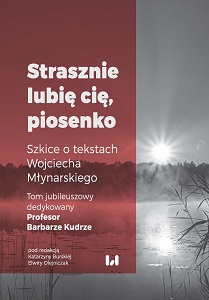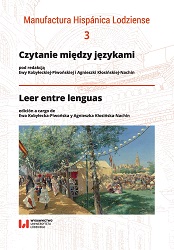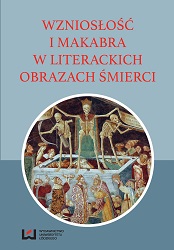
We kindly inform you that, as long as the subject affiliation of our 300.000+ articles is in progress, you might get unsufficient or no results on your third level or second level search. In this case, please broaden your search criteria.








This study, the blending of postwar Polish writer W. Szymborska (1923–2012) poetry with Carlos Bousoño’s verses (1923–2015), contemporary first generation of postwar poets in Spain, shows common trends amongst both: life projected through the means of poetry and the manifestation of life happenings through artistic expressive modes. Along with the creation of the self, to literary fiction, they choose drawing on mythology, painting, the Bible, literature itself… as demonstrations of cultural universality.
More...
There exists a deep spiritual union between poems by the Spanish author, Antonio Colinas (born 1946), and those written by Zbigniew Herbert (1924–1998), which is reflected by, among others, seeking harmony in nature and the universe. Although the poetic concept of the two authors often runs in various directions, a comparative analysis gives rise to a dia¬logue which reveals at some points surprising similarities and striking differences. When contemplating nature and arrangement of the universe both authors arrive at a conclusion that in fact the world is not an order, and what may be found in it, instead of the desired sense, is an emptiness which, however, for Colinas as opposed to Herbert, unveils the desired sense to the human being. What Herbert mostly sees is the union of suf¬fering between the human being and nature, whereas Colinas can notice a trace of some order in the omnipresent death.
More...
A re-reading of some of Zbigniew Herbert’s essays is proposed in base of a comparison with texts by Octavio Paz and Rafael Argullol. The following topics are commented: characteristics of the literary essay, the travel as geographical displacement and spiritual experience, the relationship between the individual and history, and the moderately skeptical view of Western culture, present, in different degrees, in the three authors.
More...
The aim of the article is to compare three literary pictures of the political transformation presented in The impostor (2014) by Javier Cercas, Spis cudzołożnic (1993) by Jerzy Pilch and Sońka (2014) by Ignacy Karpowicz. These novels emphasize their discursive character, thereby revealing that the history is always a narration, not an uninfected series of events. The transformation is shown in conjunction with the theme of historical memory and imposture. The transition to the democracy revealed the new ways of falsifying history, in which the culture got involved on the basis of mass communication.
More...
The aim of the present work is to provide examples which are clear illustration of the connection between Polish and Hispanic literature, in this case incarnated by the figures of Roberto Bolaño and Witold Gombrowicz: two writers known for the rebellious nature of their poetics and the urban legend of controversial which was created around their lives. Therefore, the following work proposes the approach to the life and work of both authors with the purpose of indicate relations between them, both literary and biographical, thus prove the connections which exist between Polish and Spanish letters.
More...
The article starts with the striking observation that the writing of Alejandro Zambra, a distinctive contemporary Chilean writer of the middle generation, can be treated both as a string of intriguing experiments sounding various ways of (a personal going back to) writing, and as a convenient frame of reference to discuss the notion of the progress in literature. Accordingly, a comprehensive analysis of Zambra’s literary work intertwines with questions concerning the spectrum of literary innovations, the conditions of the possibility of producing new narrative dispositives, the limitations of formal inventiveness, and the regulative function of the cognitive value added.
More...
The aim of the article was to discuss the influence of jealousy (phthonos) on the fame of godly and ungodly people and to present two divergent views on the posthumous fate, which Birkowski described with regard to three aspects: physical, religious and metaphysical – death in people remembrance.
More...
The subject of my thesis is the writing of Anna Mostowska and Łucja Rautenstrauchowa. The first of them was the one who introduced the gothic novel as a new genre at the end of the 18th century. There have been analyzed the scenes of death occurring in their novels.
More...
The article is particularly concerned with the visions of death in 19th-century illustrated editions of the Polish fictional literature. The choice of conducting such research resulted from my interest in bookas an item which is produced as the effect of cooperation of many people: author, illustrator, editor and printer. I treat the book as a whole, in which coexist both: the text and its graphic visualization.
More...
Concept of the article was to present the death in literary period Young Poland. The article basis of selected poems of Bronisława Ostrowska and Maryla Wolska.
More...
The main premise of the paper is that, for all characters, the suicidal death is most of all the manifestation of their own need to decise about themselves and to explore an art in every detail of people’s existence.
More...
Death is the natural end of life. Everything that was born must die eventually, “absent from the body and face to the Lord” as about the death Saint Paul writes. The soul is separated from the body. They connect with him again on a ‘resurrection of the dead’.
More...
In the article we make an attempt to explain poetic images of this prophecies with relation to the definition of catastrophism in Polish literature. In the text there are subjected to interpretation some representative poems, in which motifs relating to unreality could be found, for example: images of sky, symbolic representation of colours and flowers, guests from the other world, etc.
More...